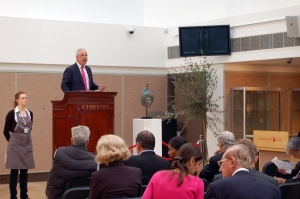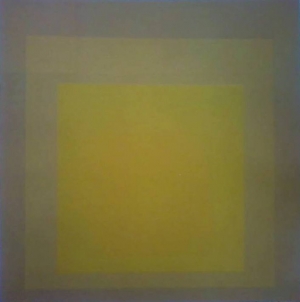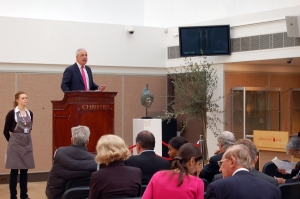|
Displaying items by tag: Christies
The New York evening sales concluded tonight with the Impressionist and modern sale at Christie’s, which racked up $145.5 million, well above its low estimate of $108.8 million—a quite successful tally accrued during a slow, steady waltz through a list of 59 relatively low-priced lots. The almost complete lack of any sky-high estimates—only two lots had valuations that passed into eight figures—allowed attendees to raise their paddles early and often, and a solid 83 percent of the cautiously priced works found buyers.
A pink diamond the size of a postage stamp is going on the auction block, and it's estimated to bring as much as $28 million.
The 16.08-carat gem is poised to set a record for a cushion-shaped fancy vivid pink diamond when Christie's offers it at its Magnificent Jewels sale in Geneva on Nov. 10.
The auction house said it is the largest diamond of its kind to come to auction.
The Josef and Anni Albers Foundation, a non-profit organization founded by the artists in 1971 and based in Bethany, Connecticut, aims to raise around $600,000 through sales of work by Josef Albers and other artists at Christie’s New York in May. The money will help fund a new culture center due to open in rural Senegal in March.
The new space, which is called “Thread”, will be located in Sinthian, a village in the southeastern region of Senegal, in a building designed by the Japanese architect Toshiko Mori.
Christie’s International Plc’s president of its Americas division will step down following the surprise departure of its chief executive officer last week.
Doug Woodham, who has held the position for two years, will leave the London-based auction house at the end of the month, Christie’s said today in an e-mailed statement.
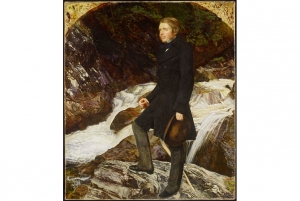
England’s Ashmolean Museum has acquired one of the most important Pre-Raphaelite paintings remaining in private hands. John Everett Millais’ (1829-1896) portrait of John Ruskin, the leading English art critic of the Victorian era, has been on loan to the institution since January 2012. The work was officially given to the museum by the Art Council England under the Acceptance in Lieu of Inheritance plan, which stipulates that under British tax law debts can be written off in exchange for objects of national significance. The painting recently appeared in Tate Britain’s highly successful exhibition Pre-Raphaelites: Victorian Avant-Garde.
Millais, one of the founders of the Pre-Raphaelite brotherhood, was commissioned to paint the portrait in 1853 by Ruskin himself. While working on the painting, Milliais fell in love with Ruskin’s wife, which ultimately led to the breakdown of the Ruskins’ marriage, Millais’ friendship with Ruskin, and the artist’s involvement with the Pre-Raphaelite movement. After marrying Ruskin’s wife, Effie, Millais gave the portrait to a friend in Oxford, Henry Wentworth Acland. The portrait remained in Acland’s family until his descendants sold it at Christie’s in 1965, where the late owner of the painting purchased it.
The Pre-Raphaelite Brotherhood, which formed in 1848, was a group of English painters, poets, and critics who rejected the traditional approaches to art and painting established by the Mannerist artists who succeeded Raphael (1483-1520) and Michelangelo (1473-1564). Instead, the Pre-Raphaelites turned to medieval and early Renaissance art for inspiration often painting subjects from Shakespeare and the Bible. Pre-Raphaelitism, which rattled Britain from 1848 to 1900, was considered the country’s first avant-garde movement.
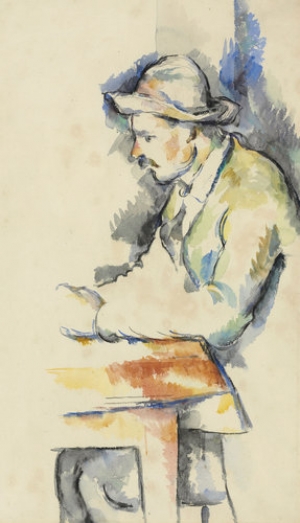
New collectors and old poured into Christie’s Rockefeller Center sales room on Tuesday night for the start of the big spring auctions. They may have come hoping for fireworks but instead sat through an anemic sale devoid of the kind of suspense and sky’s-the-limit bidding that can give these big-money evenings their excitement.
One reason was obvious: of the two auctions this week, Christie’s had far weaker material, with nothing to rival the attention-getting power of Munch’s famed pastel of “The Scream,” which is to come on the block at Sotheby’s on Wednesday.
“A number of people who have been in the market steadily over the last decade were bidders, and some who have only recently returned after dropping out for several years,” said Marc Porter, chairman and international head of private sales at Christie’s, adding that for the most part, the night’s buyers came from “traditional markets — America and Europe.”
The sale, which had been estimated to bring $90.5 million to $130.2 million, drew just over $117 million. Of the 31 lots offered, only three failed to sell.
(Final prices include the buyer’s commission to Christie’s: 25 percent of the first $50,000; 20 percent of the next $50,000 to $1 million and 12 percent of the rest. Estimates do not reflect commissions.)
Christie’s did have its own historically significant image, also a work on paper, but more of interest to connoisseurs than a trophy hunter who might try to snap up “The Scream.” It was “Card Player,” a watercolor by Cézanne of Paulin Paulet, a gardener on the estate of the artist’s family near Aix-en-Provence. A study for the artist’s famous “Card Players” series, it depicts Paulet absorbed in a game of cards. Three bidders competed for it, two on the telephone and a mystery man sitting glued to his cellphone in the second row. It was he who bought the watercolor for $17 million, or $19.1 million including Christie’s fees, just shy of its $20 million high estimate.
Where the watercolor will be heading is as unclear as where it was for nearly six decades, when scholars knew it just from black-and-white photographs. It was only recently discovered in the Dallas home of Dr. Heinz F. Eichenwald, a prominent collector who died in September.
One of the night’s few moments of passionate bidding occurred when “The Peonies,” a Matisse still life on the cover of the sale catalog, was bought by an unidentified European telephone bidder for $19.1 million. Painted in the summer of 1907 while the artist was vacationing in Collioure, a remote fishing village in southwest France, the colorful bowl of flowers had been estimated to fetch $8 million to $12 million.

In a stunning performance given the climate of economic misery, Christie’s on Tuesday sold 82 postwar and Contemporary works of 91 offered, for $247.59 million. The low 10 percent failure rate was remarkable by any standard.
A world auction record was set for Roy Lichtenstein with one of his early Pop Art pictures dating from 1961. The estimate for the scene based on a cartoon, which depicts a man peeping through an opening and shouting: “I can see the whole room ... and there’s nobody in it,” was boldly set at $35 million to $45 million. The auctioneer, Christopher Burge, brought down his hammer as a $38.5 million bid came over the telephone. The price was $43.2 million with the sale charge in excess of 12 percent.
The Lichtenstein had been acquired by its unnamed American consignor at Christie’s in November 1988 for $2.1 million.
Two other records were established for Louise Bourgeois and Paul McCarthy. A monumental bronze spider by the French-born sculptor Bourgeois cast in 1966 went up to $10.72 million, making it her most expensive work ever sold on the open market. The price exceeded the highest expectations by roughly a third. It was huge for a bronze that was cast in an edition of six, following a first edition, also of six.
The records illustrate the feverish search for works held to be icons by famous artists and acknowledged as such through multiple shows in major museums. Public display in open spaces helps. Another cast of the spider was on view in 2001 on Rockefeller Plaza between Fifth and Sixth avenues, not far from Christie’s.
Astonishing as they are, even these records did not fully reflect the wave of enthusiasm that carried the room through the first hour of the session.
The first 31 lots sold without a hitch. That is a rare feat in the Contemporary Art field, where sudden fits of weakness are more likely to happen than in most other areas, if only because there are few criteria by which aesthetic achievement or quality of execution can be measured and described in straightforward terms.
A telling indication of the bullishness of buyers was the zest with which they bid on works from the Peter Norton Collection, which accounted for the first 29 lots. A majority of them fell into what spectators who are not into Contemporary Art might be led to classify as pranks.
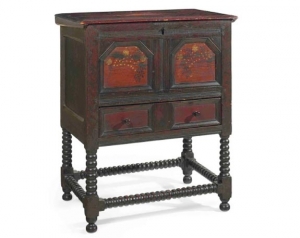
The sale of Important American Furniture, Folk Art & Decorative Arts at Christies on Wednesday did extremely well, achieving $4,488,750 and was 82% sold by lot and 76% by value. The top lot of the sale was a paint-decorated oak, cedar and pine chamber table, Boston, 1690-1710, realizing $986,500, purchased by Todd Prickett of C.L. Prickett Antiques.
John Hays, Deputy Chairman and auctioneer, comments: “The enthusiasm for important American furniture with original surfaces continues to result in extraordinary prices in this sale. We are thrilled with the exceptional price achieved for the 17th century chamber table consigned by the Wunsch Americana Foundation, continuing the trend of interest in America’s first furniture. Margot Rosenberg, Head of Department, added: “Racing Schooners- a magnificent painting of a 19th century yacht race by Antonio Jacobsen may be one of his finest and most memorable of this subject, realizing a great price after competitive bidding. We are delighted with the solid results achieved across the board and look forward to Americana Week next January.”
|
|
|
|
|


